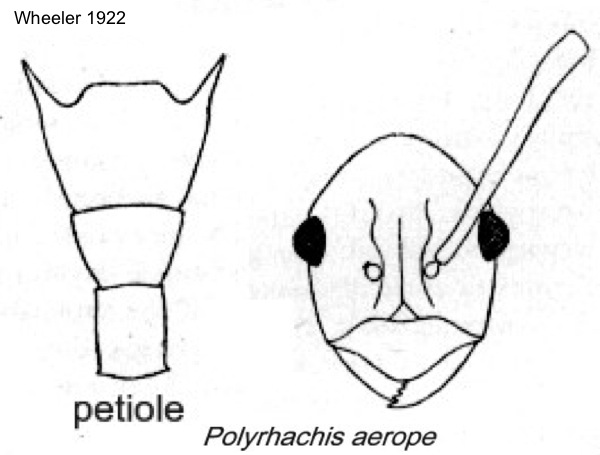 Wheeler's description (1922) of the only known worker,
collected at Niangara by Lang & Chapin, was - Wheeler's description (1922) of the only known worker,
collected at Niangara by Lang & Chapin, was -
WORKER - TL somewhat less than 6 mm. Head longer than broad,
subelliptical, not broader behind than in front, narrowed behind the
eyes to the occipital border, which is indistinctly marginate, very
convex in the middle above through the frontal carina), the cheeks
rather straight, the gular margin bluntly submarginate. Eyes at the
middle of the sides of the head, large, prominent, broadly elliptical,
their external orbits slightly sinuate. Mandibles narrow, their apical
borders rather oblique, with five subequal teeth. Clypeus convex,
bluntly carinate in the middle, its anterior border broadly rounded,
entire. Frontal area broadly triangular, indistinct; frontal carinae
high, rather closely approximated, moderately sinuate, somewhat farther
apart and subparallel behind. Antennae long, scapes slightly enlarged
and deflected at their tips, extending fully one-half their length
beyond the posterior border of the head. Thorax much like that of P.
concava, long and narrow, the dorsal surface concave with strong,
upturned lateral carinae, notched at the pronounced, transverse
promesonotal and metanotal sutures. Pronotum as long as broad, narrowed
behind, its anterior spines straight, acute, slightly divergent,
flattened, more than twice as long as their width at the base.
Mesonotum trapezoidal like the pronotum, but smaller and broader than
long; base of propodeum regularly rectangular, one and one-third times
as long as broad, its posterior corners with two small, erect, slightly
recurved teeth, which are as long as broad at their bases, its
posterior border not marginate but, as with concava, passing
over into the sloping declivity, which is slightly longer than the base
and feebly convex in profile. Petiole and gaster shaped as in concava,
but with the median pair of spines of the former straight, when seen
from the front, and not slightly curved inward. Tibiae distinctly
constricted at their bases. Shining; gaster smooth and polished.
Mandibles finely striated and sparsely and finely punctate; head,
thorax, and petiole finely coriaceous or shagreened; the clypeus
somewhat smoother. Gaster very minutely and superficially punctate.
Colour black, palpi and antennal insertions reddish (Bolton, 1973b:
296, not illustrated).
Although, as Bolton commented, this appears very close
to Polyrhachis concava,
the specimen below has a more slender alitrunk, both viewed from above
and laterally. It also is noticeably smoother and shinier.
See also https://www.antweb.org/specimenImages.do?code=casent0281441 from Cameroun.
|